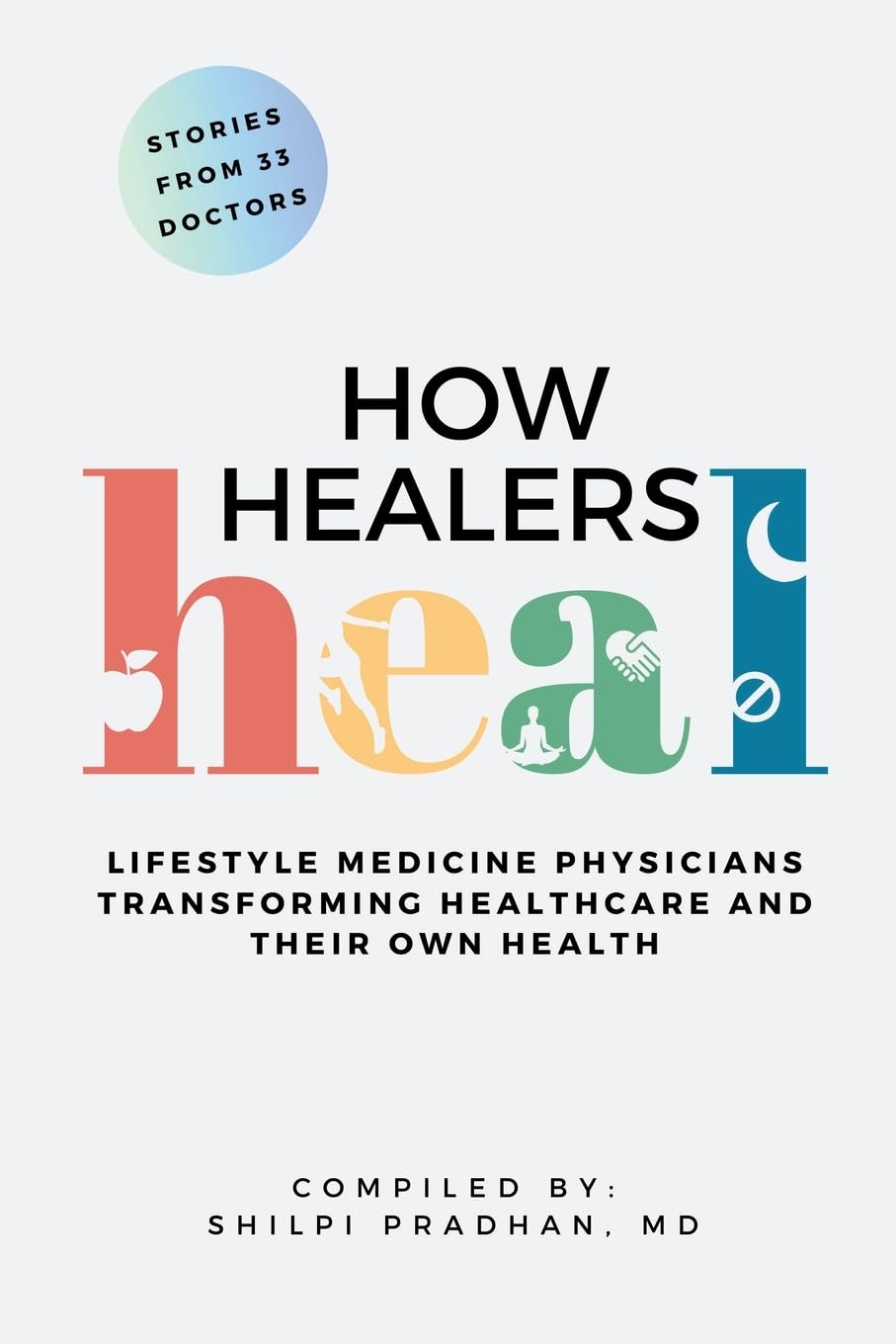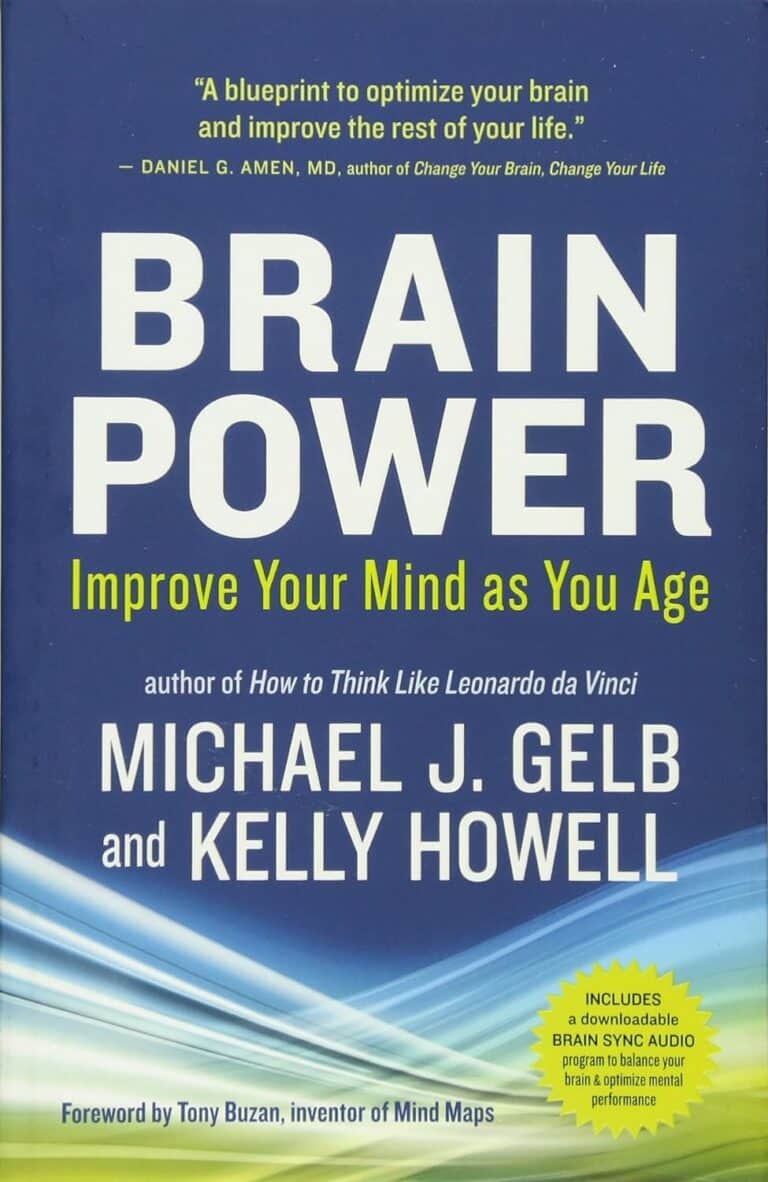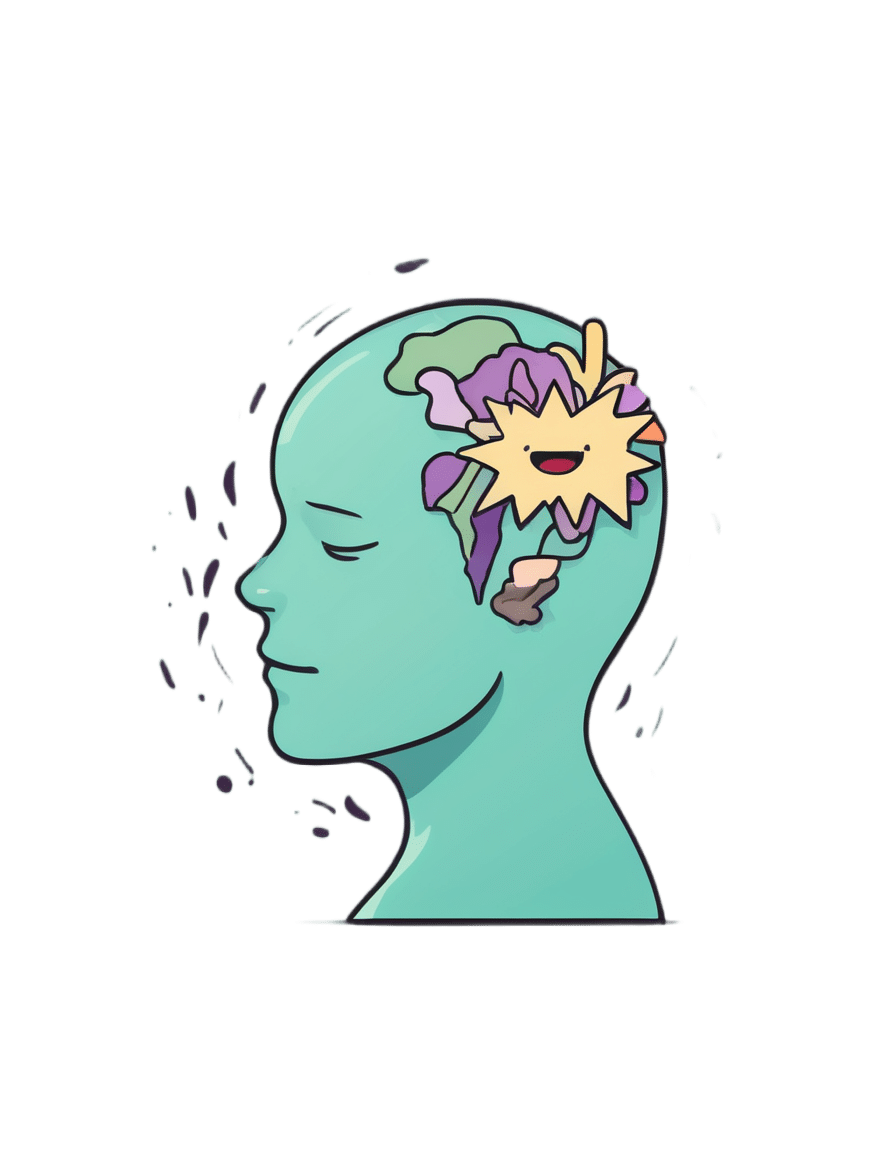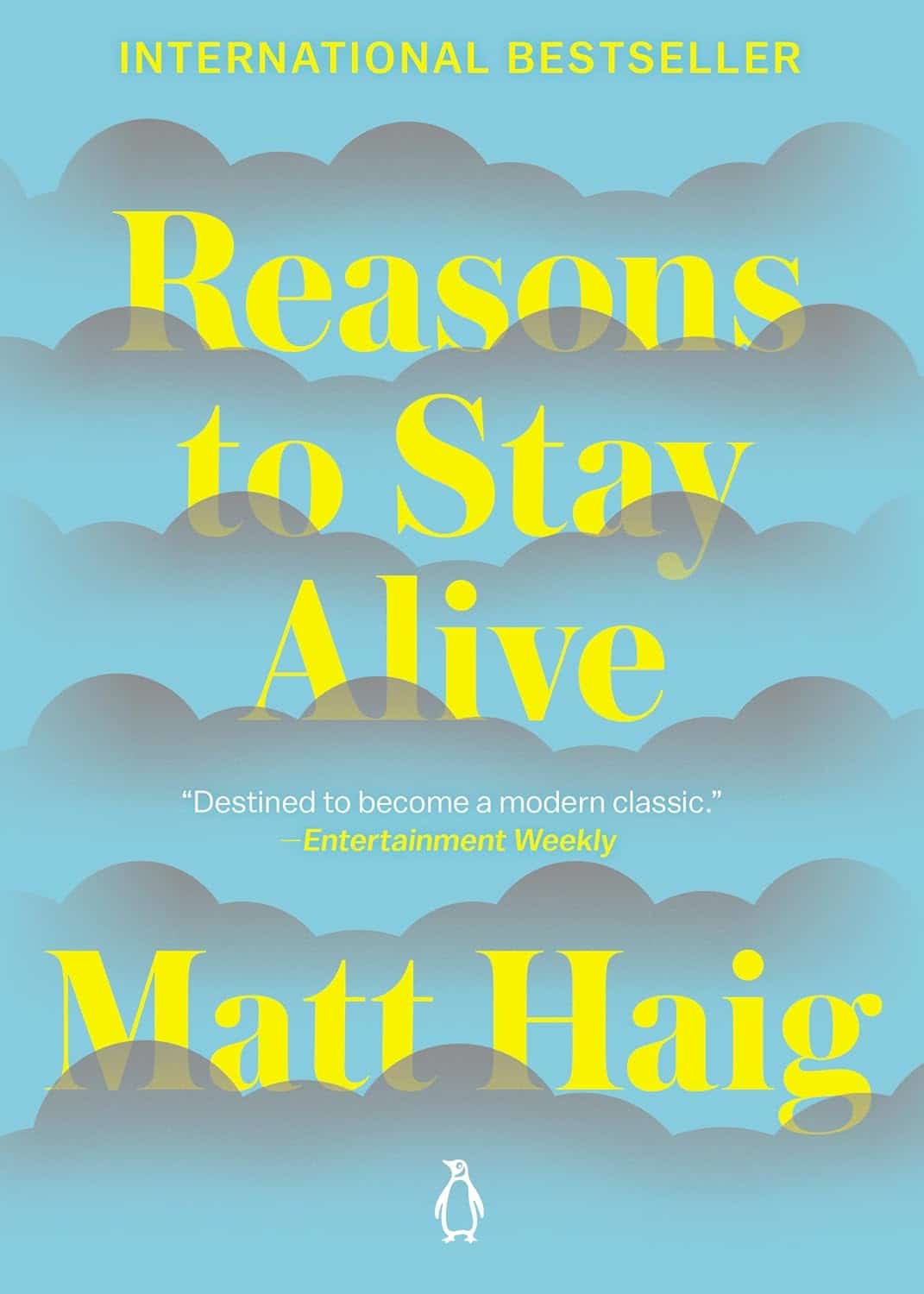
How Healers Heal – by Dr. Shilpi Pradhan
10almonds is reader-supported. We may, at no cost to you, receive a portion of sales if you purchase a product through a link in this article.
First note: the listed author here is in fact the compiler, with the authors being a collection of no fewer than 33 board-certified lifestyle medicine physicians. So, we’re not getting just a single person’s opinions/bias here!
But what is lifestyle medicine? This book holds the six pillars of lifestyle medicine to be:
- Nutrition
- Physical activity
- Stress management
- Restorative sleep
- Social connections
- Avoidance of risky substances
…and those things are what we read about throughout the book, both in highly educational mini-lecture form, and sometimes highly personal storytelling.
It’s not just a “do these things” book, though yes, there’s a large part of that. It also covers wide topics, from COVID to alopecia, burnout to grief, immune disorders to mysterious chest pains (and how such mysteries are unravelled, when taken seriously).
One of the greatest strengths of this book is that it’s very much “medicine, as it should be”, so that the reader knows how to recognize the difference.
Bottom line: this book doesn’t fit into a very neat category, but it’s a very worthwhile book to read, and one that could help inform a decision that changes the entire path of your life or that of a loved one.
Click here to check out How Healers Heal, and learn to recognize the healthcare you deserve!
Don’t Forget…
Did you arrive here from our newsletter? Don’t forget to return to the email to continue learning!
Recommended
Learn to Age Gracefully
Join the 98k+ American women taking control of their health & aging with our 100% free (and fun!) daily emails:
-
What Happens Every Day When You Quit Sugar For 30 Days
10almonds is reader-supported. We may, at no cost to you, receive a portion of sales if you purchase a product through a link in this article.
We all know that sugar isn’t exactly a health food, but it can be hard to quit. How long can cravings be expected to last, and when can we expect to see benefits? Today’s video covers the timeline in a realistic yet inspiring fashion:
What to expect on…
Day 1: expect cravings and withdrawal symptoms including headaches, fatigue, mood swings, and irritability—as well as tiredness, without the crutch of sugar.
Days 2 & 3: more of the same, plus likely objections from the gut, since your Candida albicans content will not be enjoying being starved of its main food source.
Days 4–7: reduction of the above symptoms, better energy levels, improved sleep, and likely the gut will be adapting or have adapted.
Days 8–14: beginning of weight loss, clearer skin, improved complexion; taste buds adapt too, making foods taste sweeter. Continued improvement in energy and focus, as well.
Days 15–21: more of the same improvements, plus the immune system will start getting stronger around now. But watch out, because there may still be some cravings from time to time.
Days 22–30: all of the above positive things, few or no cravings now, and enhanced metabolic health as a whole.
For more specificity on each of these stages, enjoy:
Click Here If The Embedded Video Doesn’t Load Automatically!
Want to learn more?
You might also like to read:
The Not-So-Sweet Science Of Sugar Addiction
Take care!
Share This Post
-
Lower Your Cortisol! (Here’s Why & How)
10almonds is reader-supported. We may, at no cost to you, receive a portion of sales if you purchase a product through a link in this article.
Cortisol, or “the stress hormone” to its friends, is produced by your adrenal glands, and is generally considered “not fun”.
It does serve a purpose, of course, just like almost everything else our body does. It serves as part of the “fight or flight” response, for example, and helps you to wake up in the morning.
While you do need some cortisol (and a small percentage of people have too little), most of us have too much.
Why? Simply put, modern life is not what 200,000* years of human evolution prepared us for:
- Agriculture (which allowed us to settle down and cease being nomadic) happened during the last 6% of those 200,000 years.
- The Industrial Revolution and the onset of modern capitalism happened during only during the last 0.1% of those 200,000 years.
*the 200,000 years figure is conservative and doesn’t take into account the 200,000,000 years of pre-hominid mammalian evolution. Doing so, on the basis of the mammalian brain & physiology being what’s important here, means our modern stressors have been around for <0.0001% of the time we have.
So guess what, our bodies haven’t caught up. As far as our bodies are concerned, we are supposed to be enjoying the sunshine of grassy plains and the shade of woodland while eating fruit.
- When the alarm clock goes off, our body panics and prepares us to either flee or help fight the predator, because why else would we have been woken so?
- When we have a pressing deadline for work, our brain processes this as “if we don’t do this, we will literally starve and die”.
- When people are upset or angry with us, there’s a part of our brain that fears exile from the tribe and resultant death.
…and so on.
Health Risks of High Cortisol
The long-term stressors are the biggest issue for health. Unless you have a heart condition or other relevant health problem, almost anyone can weather a brief unpleasant surprise. But if something persists? That prompts the body to try to protect you, bless it. The body’s attempts backfire, because…
- One way it does this by making sure to save as much food as possible in the form of body fat
- It’ll also increase your appetite, to make sure you eat anything you can while you still can
- It additionally tries to protect you by keeping you on the brink of fight-or-flight readiness, e.g:
- High blood pressure
- High blood sugar levels
- Rapid mood changes—gotta be able to do those heel-turns as necessary and react quickly to any possible threat!
Suffice it to say, these things are not good for your long-term health.
That’s the “Why”—now here’s the “How”:
Lowering your cortisol levels mostly means lowering your stress and/or lowering your stress response. We previously gave some powerful tools for lowering anxiety, which for these purposes amounts to the same thing.
However, we can also make nutritional and lifestyle changes that will reduce our cortisol levels, for example:
- Reduce (ideally: eliminate from your lifestyle) caffeine
- Reduce (ideally: eliminate from your lifestyle) alcohol
- Yes, really. While many understandably turn to alcohol specifically to help manage stress, it only makes it worse long-term.
- Additionally, alcohol directly stimulates cortisol production, counterintuitive as that may be.
Read: Alcohol, Aging, and the Stress Response ← full article (with 37 sources of its own) from the NYMC covering how alcohol stimulates cortisol production and what that means for us
As well as reductions/eliminations, are some things you can add into your lifestyle that will help!
We’ve written previously about some:
Read: Ashwagandha / Read: L-Theanine / Read: CBD Oil
Other things include, no surprises here:
- The Mediterranean diet (nutritious and delicious): https://10almonds.com/mediterranean-diet
- Get 7–9 hours (good quality!) sleep per night: https://10almonds.com/time-pillow-talk
- Get regular exercise (the regularity matters most!): https://10almonds.com/keep-on-keeping-on
Progressive Relaxation
We’ll give this one its own section because we’ve not talked about it before. Maybe you’re familiar. If not, then in a nutshell: progressive relaxation means progressively tensing and then relaxing each part of your body in turn.
Why does this work? Part of it is just a physical trick involving biofeedback and the natural function of muscles to contract and relax in turn, but the other part is even cleverer:
It basically tricks the most primitive part of your brain, the limbic system, into thinking you had a fight and won, telling it “thank you very much for the cortisol but we don’t need it anymore”.
Take a Hike! Or a Stroll… You Do You!
Last but not least: go connect with your roots. Spend time in the park, or at least the garden. Have a picnic, if the weather suits. Go somewhere you can spend time around leafy green things under a blue sky (we realize the blue sky may be subject to availability in some locations, but do what you can!).
Remember also: just as your body’s responses will be tricked by the alarm clock or the housework, they will also be easily tricked by blue and green stuff around you. If a sunny garden isn’t available in your location, a picture of one as your desktop background is the next best thing.
Share This Post
-
The Philosophy Gym – by Dr. Stephen Law
10almonds is reader-supported. We may, at no cost to you, receive a portion of sales if you purchase a product through a link in this article.
If you’d like to give those “little gray cells” an extra workout, this book is a great starting place.
Dr. Stephen Law is Director of Philosophy at the Department of Continuing Education, University of Oxford. As such, he’s no stranger to providing education that’s both attainable and yet challenging. Here, he lays out important philosophical questions, and challenges the reader to get to grips with them in a systematic fashion.
Each of the 25 questions/problems has a chapter devoted to it, and is ranked:
- Warm-up
- Moderate
- More Challenging
But, he doesn’t leave us to our own devices, nor does he do like a caricature of a philosopher and ask us endless rhetorical questions. Instead, he looks at various approaches taken by other philosophers over time, and invites the reader to try out those methods.
The real gain of this book is not the mere enjoyment of reading, but rather in taking those thinking skills and applying them in life… because most if not all of them do have real-world applications and/or implications too.
The book’s strongest point? That it doesn’t assume prior knowledge (and yet also doesn’t patronize the reader). Philosophy can be difficult to dip one’s toes into without a guide, because philosophers writing about philosophy can at first be like finding yourself at a party where you know nobody, but they all know each other.
In contrast, Law excels at giving quick, to-the-point ground-up summaries of key ideas and their progenitors.
In short: a wonderful way to get your brain doing things it might not have tried before!
Share This Post
Related Posts
-
In Crisis, She Went to an Illinois Facility. Two Years Later, She Still Isn’t Able to Leave.
10almonds is reader-supported. We may, at no cost to you, receive a portion of sales if you purchase a product through a link in this article.
Series: Culture of Cruelty:Inside Illinois’ Mental Health System
State-run facilities in Illinois are supposed to care for people with mental and developmental disabilities. But patients have been subjected to abuse, neglect and staff misconduct for decades, despite calls for change.
Kaleigh Rogers was in crisis when she checked into a state-run institution on Illinois’ northern border two years ago. Rogers, who has cerebral palsy, had a mental health breakdown during the pandemic and was acting aggressively toward herself and others.
Before COVID-19, she had been living in a small group home; she had been taking college classes online and enjoyed going out with friends, volunteering and going to church. But when her aggression escalated, she needed more medical help than her community setting could provide.
With few viable options for intervention, she moved into Kiley Developmental Center in Waukegan, a much larger facility. There, she says she has fewer freedoms and almost nothing to do, and was placed in a unit with six other residents, all of whom are unable to speak. Although the stay was meant to be short term, she’s been there for two years.
The predicament facing Rogers and others like her is proof, advocates say, that the state is failing to live up to the promise it made in a 13-year-old federal consent decree to serve people in the community.
Rogers, 26, said she has lost so much at Kiley: her privacy, her autonomy and her purpose. During dark times, she cries on the phone to her mom, who has reduced the frequency of her visits because it is so upsetting for Rogers when her mom has to leave.
The 220-bed developmental center about an hour north of Chicago is one of seven in the state that have been plagued by allegations of abuse and other staff misconduct. The facilities have been the subject of a monthslong investigation by Capitol News Illinois and ProPublica about the state’s failures to correct poor conditions for people with intellectual and developmental disabilities. The news organizations uncovered instances of staff who had beaten, choked, thrown, dragged and humiliated residents inside the state-run facilities.
Advocates hoped the state would become less reliant on large institutions like these when they filed a lawsuit in 2005, alleging that Illinois’ failure to adequately fund community living options ended up segregating people with intellectual and developmental disabilities from society by forcing them to live in institutions. The suit claimed Illinois was in direct violation of a 1999 U.S. Supreme Court decision in another case, which found that states had to serve people in the most integrated setting of their choosing.
Negotiations resulted in a consent decree, a court-supervised improvement plan. The state agreed to find and fund community placements and services for individuals covered by the consent decree, thousands of adults with intellectual and developmental disabilities across Illinois who have put their names on waiting lists to receive them.
Now, the state has asked a judge to consider ending the consent decree, citing significant increases in the number of people receiving community-based services. In a court filing in December, Illinois argued that while its system is “not and never will be perfect,” it is “much more than legally adequate.”
But advocates say the consent decree should not be considered fulfilled as long as people with disabilities continue to live without the services and choices that the state promised.
Across the country, states have significantly downsized or closed their large-scale institutions for people with developmental and intellectual disabilities in favor of smaller, more integrated and more homelike settings.
But in Illinois, a national outlier, such efforts have foundered. Efforts to close state-operated developmental centers have been met with strong opposition from labor unions, the communities where the centers are located, local politicians and some parents.
U.S. District Judge Sharon Johnson Coleman in Chicago is scheduled in late summer to decide whether the state has made enough progress in building up community supports to end the court’s oversight.
For some individuals like Rogers, who are in crisis or have higher medical or behavioral challenges, the state itself acknowledges that it has struggled to serve them in community settings. Rogers said she’d like to send this message on behalf of those in state-operated developmental centers: “Please, please get us out once and for all.”
“Living Inside a Box”
Without a robust system of community-based resources and living arrangements to intervene during a crisis, state-operated developmental centers become a last resort for people with disabilities. But under the consent decree agreement, the state, Equip for Equality argues, is expected to offer sufficient alternative crisis supports to keep people who want them out of these institutions.
In a written response to questions, Rachel Otwell, a spokesperson for the Illinois Department of Human Services, said the state has sought to expand the menu of services it offers people experiencing a crisis, in an effort to keep them from going into institutions. But Andrea Rizor, a lawyer with Equip for Equality, said, “They just don’t have enough to meet the demand.”
For example, the state offers stabilization homes where people can live for 90 days while they receive more intensive support from staff serving the homes, including medication reviews and behavioral interventions. But there are only 32 placements available — only four of them for women — and the beds are always full, Rizor said.
Too many people, she said, enter a state-run institution for short-term treatment and end up stuck there for years for various reasons, including shortcomings with the state’s discharge planning and concerns from providers who may assume those residents to be disruptive or difficult to serve without adequate resources.
That’s what happened to Rogers. Interruptions to her routine and isolation during the pandemic sent her anxiety and aggressive behaviors into overdrive. The staff at her community group home in Machesney Park, unsure of what to do when she acted out, had called the police on several occasions.
Doctors also tried to intervene, but the cocktail of medications she was prescribed turned her into a “zombie,” Rogers said. Stacey Rogers, her mom and legal guardian, said she didn’t know where else to turn for help. Kiley, she said, “was pretty much the last resort for us,” but she never intended for her daughter to be there for this long. She’s helped her daughter apply to dozens of group homes over the past year. A few put her on waitlists; most have turned her down.
“Right now, all she’s doing is living inside a box,” Stacey Rogers said.
Although Rogers gave the news organizations permission to ask about her situation, IDHS declined to comment, citing privacy restrictions. In general, the IDHS spokesperson said that timelines for leaving institutions are “specific to each individual” and their unique preferences, such as where they want to live and speciality services they may require in a group home.
Equip for Equality points to people like Rogers to argue that the consent decree has not been sufficiently fulfilled. She’s one of several hundred in that predicament, the organization said.
“If the state doesn’t have capacity to serve folks in the community, then the time is not right to terminate this consent decree, which requires community capacity,” Rizor said.
Equip for Equality has said that ongoing safety issues in these facilities make it even more important that people covered by the consent decree not be placed in state-run institutions. In an October court brief, citing the news organizations’ reporting, Equip for Equality said that individuals with disabilities who were transferred from community to institutional care in crisis have “died, been raped, and been physically and mentally abused.”
Over the summer, an independent court monitor assigned to provide expert opinions in the consent decree, in a memo to the court, asked a judge to bar the state from admitting those individuals into its institutions.
In its December court filing, the state acknowledged that there are some safety concerns inside its state-run centers, “which the state is diligently working on,” as well as conditions inside privately operated facilities and group homes “that need to be addressed.” But it also argued that conditions inside its facilities are outside the scope of the consent decree. The lawsuit and consent decree specifically aimed to help people who wanted to move out of large private institutions, but plaintiffs’ attorneys argue that the consent decree prohibits the state from using state-run institutions as backup crisis centers.
In arguing to end the consent decree, the state pointed to significant increases in the number of people served since it went into effect. There were about 13,500 people receiving home- and community-based services in 2011 compared with more than 23,000 in 2023, it told the court.
The state also said it has significantly increased funding that is earmarked to pay front-line direct support professionals who assist individuals with daily living needs in the community, such as eating and grooming.
In a statement to reporters, the human services department called these and other improvements to the system “extraordinary.”
Lawyers for the state argued that those improvements are enough to end court oversight.
“The systemic barriers that were in place in 2011 no longer exist,” the state’s court filing said.
Among those who were able to find homes in the community is Stanley Ligas, the lead plaintiff in the lawsuit that led to the consent decree. When it was filed in 2005, he was living in a roughly 100-bed private facility but wanted to move into a community home closer to his sister. The state refused to fund his move.
Today, the 56-year-old lives in Oswego with three roommates in a house they rent. All of them receive services to help their daily living needs through a nonprofit, and Ligas has held jobs in the community: He previously worked in a bowling alley and is now paid to make public appearances to advocate for others with disabilities. He lives near his sister, says he goes on family beach vacations and enjoys watching professional wrestling with friends. During an interview with reporters, Ligas hugged his caregiver and said he’s “very happy” and hopes others can receive the same opportunities he’s been given.
While much of that progress has come only in recent years, under Gov. JB Pritzker’s administration, it has proven to be vulnerable to political and economic changes. After a prolonged budget stalemate, the court in 2017 found Illinois out of compliance with the Ligas consent decree.
At the time, late and insufficient payments from the state had resulted in a staffing crisis inside community group homes, leading to escalating claims of abuse and neglect and failures to provide routine services that residents relied on, such as help getting to work, social engagements and medical appointments in the community. Advocates worry about what could happen under a different administration, or this one, if Illinois’ finances continue to decline as projected.
“I acknowledge the commitments that this administration has made. However, because we had so far to come, we still have far to go,” said Kathy Carmody, chief executive of The Institute on Public Policy for People with Disabilities, which represents providers.
While the wait for services is significantly shorter than it was when the consent decree went into effect in 2011, there are still more than 5,000 adults who have told the state they want community services but have yet to receive them, most of them in a family home. Most people spend about five years waiting to get the services they request. And Illinois continues to rank near the bottom in terms of the investment it makes in community-based services, according to a University of Kansas analysis of states’ spending on services for people with intellectual and developmental disabilities.
Advocates who believe the consent decree has not been fulfilled contend that Illinois’ continued reliance on congregate settings has tied up funds that could go into building up more community living options. Each year, Illinois spends about $347,000 per person to care for those in state-run institutions compared with roughly $91,000 per person spent to support those living in the community.
For Rogers, the days inside Kiley are long, tedious and sometimes chaotic. It can be stressful, but Rogers told reporters that she uses soothing self-talk to calm herself when she feels sad or anxious.
“I tell myself: ‘You are doing good. You are doing great. You have people outside of here that care about you and cherish you.’”
This article is republished from ProPublica under a Creative Commons license. Read the original article.
Don’t Forget…
Did you arrive here from our newsletter? Don’t forget to return to the email to continue learning!
Learn to Age Gracefully
Join the 98k+ American women taking control of their health & aging with our 100% free (and fun!) daily emails:
-
Reasons to Stay Alive – by Matt Haig
10almonds is reader-supported. We may, at no cost to you, receive a portion of sales if you purchase a product through a link in this article.
We’ve previously reviewed Matt Haig’s (excellent) The Comfort Book, and now it’s time for his more famous book: Reasons To Stay Alive. So, what’s this one, beyond the obvious?
It narrates the experience of anxiety, depression, and suicidality, and discovering how to find beauty and joy in the world despite it all. It’s not that the author found a magical cure—he still experiences depression and anxiety (cannot speak for suicidality) but he knows now how to manage it, and live his life.
You may be wondering: is this book instructional; is it reproducible, or is it just an autobiography? It’s centered around his own experience and learnings, but it gives a huge sense of not feeling alone, of having hope, and it gives a template for making sense of one’s own experience, even if every person will of course have some points of differences, the commonalities are nonetheless of immense value.
The writing style is similar to The Comfort Book; it’s lots of small chapters, and all very easy-reading. Well, the subject matter is sometimes rather heavy, but the language is easy-reading! In other words, just the thing for when one is feeling easily overwhelmed, or not feeling up to reading a lot.
Bottom line: whether or not you suffer with anxiety and/or depression, whether or not you sometimes feel suicidal, the contents of this book are important, valuable insights for everyone.
Click here to check out Reasons To Stay Alive, and see through the highs and lows of life.
Don’t Forget…
Did you arrive here from our newsletter? Don’t forget to return to the email to continue learning!
Learn to Age Gracefully
Join the 98k+ American women taking control of their health & aging with our 100% free (and fun!) daily emails:
-
Proteins Of The Week
10almonds is reader-supported. We may, at no cost to you, receive a portion of sales if you purchase a product through a link in this article.
This week’s news round-up is, entirely by chance, somewhat protein-centric in one form or another. So, check out the bad, the very bad, the mostly good, the inconvenient, and the worst:
Mediterranean diet vs the menopause
Researchers looked at hundreds of women with an average age of 51, and took note of their dietary habits vs their menopause symptoms. Most of them were consuming soft drinks and red meat, and not good in terms of meeting the recommendations for key food groups including vegetables, legumes, fruit, fish and nuts, and there was an association between greater adherence to Mediterranean diet principles, and better health.
Read in full: Fewer soft drinks and less red meat may ease menopause symptoms: Study
Related: Four Ways To Upgrade The Mediterranean Diet
Listeria in meat
This one’s not a study, but it is relevant important news. The headline pretty much says it all, so if you don’t eat meat, this isn’t one you need to worry about any further than that. If you do eat meat, though, you might want to check out the below article to find out whether the meat you eat might be carrying listeria:
Read in full: Almost 10 million pounds of meat recalled due to Listeria danger
Related: Frozen/Thawed/Refrozen Meat: How Much Is Safety, And How Much Is Taste?
Brawn and brain?
A study looked at cognitively healthy older adults (of whom, 57% women), and found an association between their muscle strength and their psychological wellbeing. Note that when we said “cognitively healthy”, this means being free from dementia etc—not necessarily psychologically health in all respects, such as also being free from depression and enjoying good self-esteem.
Read in full: Study links muscle strength and mental health in older adults
Related: Staying Strong: Tips To Prevent Muscle Loss With Age
The protein that blocks bone formation
This one’s more clinical but definitely of interest to any with osteoporosis or at high risk of osteoporosis. Researchers identified a specific protein that blocks osteoblast function, thus more of this protein means less bone production. Currently, this is not something that we as individuals can do anything about at home, but it is promising for future osteoporosis meds development.
Read in full: Protein blocking bone development could hold clues for future osteoporosis treatment
Related: Which Osteoporosis Medication, If Any, Is Right For You?
Rabies risk
People associate rabies with “rabid dogs”, but the biggest rabies threat is actually bats, and they don’t even need to necessarily bite you to confer the disease (it suffices to have licked the skin, for instance—and bats are basically sky-puppies who will lick anything). Because rabies has a 100% fatality rate in unvaccinated humans, this is very serious. This means that if you wake up and there’s a bat in the house, it doesn’t matter if it hasn’t bitten anyone; get thee to a hospital (where you can get the vaccine before the disease takes hold; this will still be very unpleasant but you’ll probably survive so long as you get the vaccine in time).
Read in full: What to know about bats and rabies
Related: Dodging Dengue In The US ← much less serious than rabies, but still not to be trifled with—particularly noteworthy if you’re in an area currently affected by floodwaters or even just unusually heavy rain, by the way, as this will leave standing water in which mosquitos breed.
Take care!
Don’t Forget…
Did you arrive here from our newsletter? Don’t forget to return to the email to continue learning!
Learn to Age Gracefully
Join the 98k+ American women taking control of their health & aging with our 100% free (and fun!) daily emails:







